Clinical Pediatrics: Open Access
Open Access
ISSN: 2572-0775
ISSN: 2572-0775
Research Article - (2023)Volume 8, Issue 2
Purpose: To explore each factor's relationship and clinical significance by analyzing and comparing multiple clinical factors between children with growing pain and normal children.
Methods: The clinical data of 100 children with growing pain and 400 normal children from March 2022 to October 2022 in the Pediatric Surgery Clinic of Weifang People's Hospital were collected; including 61 males and 39 females, the mean age was 55.39 ± 27.97 months. Statistical analysis was performed using SPSS 26.0 software and paired independent samples t-test was used to compare groups.
Results: The medial ankle distance in the growing pain group (4.37 ± 2.12 cm) was greater than that in the control group (1.81 ± 1.00 cm) (P<0.001); in the growing pain group, the medial ankle distance in overweight children (5.72 ± 2.79 cm) was greater than that in normal weight children (4,10 ± 1.84 cm), the difference was statistically significant (P=0.0035); there was no significant difference in weight and height between the two groups (P>0.05). 64% of the children who were followed up for more than half a year improved significantly.
Conclusion: Compared with normal children, the medial ankle distance in children with growing pain increased significantly, indicating that it was related to genu valgum; no difference in weight and height was found between the two groups; however, the overweight children in the growing pain group had significant medial ankle distance. The children's predilection age, age group distribution, pain location, and medical record have specific clinical characteristics. This analysis has particular clinical significance for the further understanding and treatment of growing pains.
Growing pains; Medial ankle distance; Pediatric; Growth
A standard, non-malignant syndrome of recurrent discomfort, known as growing pains, occurs during childhood development and is a disorder with a benign and self-limiting course [1]. Children aged 3 to 12 years are most often affected, and the painful area is predominantly in the legs [2]. One study found that the mean age of children with growing pains was 8.6 ± 2.5 years, but the discomfort generally started from 3 to 6 years of age [3]. The pain occurs mainly in the crus or near the knee joint, and most (80-90%) describe bilateral pain, sometimes alternating between the two limbs [2]. A study in the journal Lancet in 1928 showed that the incidence of growing pains decreased with the age of children [4], but in their study, children younger than eight years include. In contrast, a study in the Journal of Pediatrics found 36.9% of growing pains in patients aged 4 years to 6 years in the Australian population [4].
Although current studies have a wide range of prevalence estimates, we believe that most of their inconsistent prevalence is due to differences and biases in age ranges. The purpose of this study was to better understand the characteristics of growing pain in children by analyzing and comparing age, sex, height, weight, inner knee distance, medial ankle distance, medical record, clinical features, and disease outcome in 500 children attending our hospital. For this purpose, we selected 100 children with growing pains and 400 normal children for analysis. The results present below.
In this study, 100 children diagnosed with growing pains were selected as the pain group and 400 normal children as the control group. In the pain group, 61 males and 39 females; 17 were found to be above average weight and did not have rickets; 13 of them had rickets themselves and had average weight. Methods Figure 1A: When the patients were in the decubitus lying position, the lower limbs were straightened and naturally leaned together with the patella to the front, the length of both lower limbs observe, and the medial ankle distance and inner knee distance were measures with a commercially available ordinary tape measure, and the weight measures with a weight scale. X-leg or O-leg due to rickets such as rib exostosis or square cranium, pain due to history of trauma, and other lesions exclude. The incidence distribution by age group, the prevalence by gender, the predilection site, and the average age of onset were studied separately; the differences in weight, height, and internal ankle distance between the pain group and the control group, and the comparison of the medial ankle distance; the correlation of weight and height on the ankle distance in the pain group, and the comparison of the medial ankle distance between overweight and normal weight children, and the effect of rickets on their internal ankle distance (Figures 1A and 1B). To exclude the interference factors of height and weight caused by different ages, 100 children were selected from the control group and the pain group, respectively, with 51 months as the age group boundary, and the differences in height, weight, and ankle distance between the two groups were compared (Figures 2A and 2B).
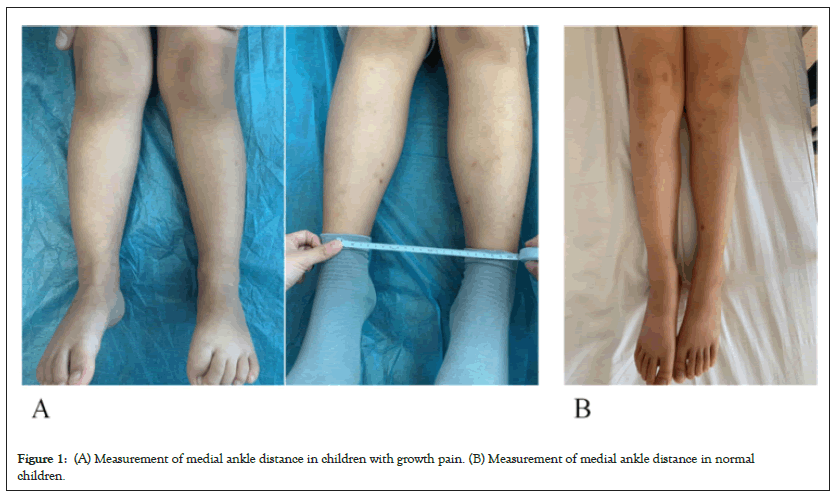
Figure 1: (A) Measurement of medial ankle distance in children with growth pain. (B) Measurement of medial ankle distance in normal children.
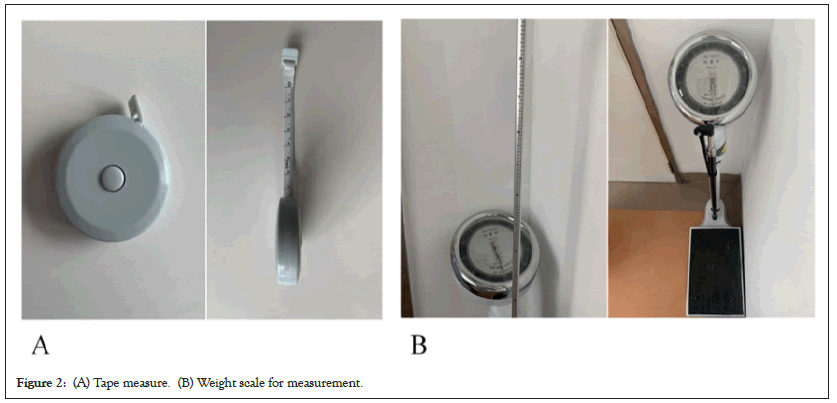
Figure 2: (A) Tape measure. (B) Weight scale for measurement.
Statistical methods: SPSS28.0.1.1 software uses for statistical analysis, and the data were all normally distributed; the comparison between the two groups makes by paired independent samples t-test; the study between the two variables do by Pearson correlation analysis; Mean ± SD expressed the data; the graphing do by GraphPrism9.0.0(121) software was completed.
Growing pain has not been defined and is usually diagnosed using an exclusive diagnosis and radiological examination, suggesting no abnormality. Laboratory tests to diagnose growing pain are unnecessary in healthy children with typical limb pain and a routine physical examination [5]. Unilateral location of pain may be an exclusion criterion [6]; some studies have shown that unilateral nocturnal leg pain is most commonly associated with osteoid osteoma [2]. Physical examination of patients with growing pain is generally routine. For some children with an atypical medical record, systemic symptoms such as lameness or any signs of decreased or limited mobility, non-benign signs, and symptoms such as swelling, erythema, and tenderness in any part of the extremity, further investigation requires [7].
Our data showed that there was no significant difference in height and weight between the pain group and the control group (P>0.05), but there was a significant difference in ankle distance (P<0.001). In the pain group, the ankle distance (4.37 ± 2.12 cm) was greater than that of the control group (1.81 ± 1.00 cm), and the p-value was less than 0.001 the difference was statistically significant. However, height did not correlate with ankle distance in the pain group, whereas weight did. The medial ankle distance was more significant in overweight children (5.72 ± 2.79 cm) than in normalweight children (4,10 ± 1.84 cm), with a p-value of 0.0035 (<0.05) a statistically significant difference. There was no correlation between height and medial ankle distance in the pain or control groups. Furthermore, in our study and at the same weight, medial ankle distance was more significant in boys than in girls, both in the experimental and control groups. However, one case of a child with growing pains with average medial ankle distance and abnormal inner knee distance was found in our study and was not counted in the sample data because the sample was too sparse. Our findings suggest that 75% of the 100 children with growing pain had a predilection for the anterior tibia, and 19% preferred the knee joint. This is consistent with our data showing that anterior tibial is the most common. However, it has also shown that growing pains are also present in the upper extremities, but this is much less common [4]. Similarly, our study found one case of pelvic pain, one case of hip pain, one case of left elbow, one case of the thigh, and two cases of low back pain. The prevalence was more significant in boys (61%) than in girls (39%), and the percentage of children with growing pains was 62% for those younger than five years, 21% for those between five and seven years, and 17% for those older than seven years. Long-term follow-up data suggest that after three months of treatment with oral vitamin D, calcium supplementation, and increased daylight hours on the body surface, 64% of the children showed improvement in the pain level of growing pains. Furthermore, the data showed that 69% of the children did not deny having a history of activity in their medical records. Our study showed no significant difference between rickets and medial malleolus distance in the pain group (Tables 1 and 2) and (Figures 3A and 3B).
| Experimental groups | Weight (kg, Mean ± SD) | Height (cm, Mean ± SD) | Medial ankle distance (cm, Mean ± SD) |
|---|---|---|---|
| GP | 13.29 ± 2.43 | 89.62 ± 10.24 | 4.45 ± 1.92 |
| Normal | 13.11 ± 1.45 | 93.25 ± 7.59 | 1.57 ± 0.83 |
| P | >0.05 | >0.05 | <0.001 |
Table 1: <51 months (n=98), differences in height, weight, and medial ankle distance between the pain and experimental groups (Growing Pain (GP), Control Group (NC)).
| Experimental groups | Weight (kg, Mean ± SD) | Height (cm, Mean ± SD) | Medial ankle distance (cm, Mean ± SD) |
|---|---|---|---|
| GP | 21.44 ± 6.36 | 117.67 ± 15.01 | 4.30 ± 2.28 |
| Normal | 19.45 ± 3.90 | 117.50 ± 13.43 | 1.89 ± 0.87 |
| P | >0.05 | >0.05 | <0.001 |
Table 2: 51-146 months (n=102), differences in height, weight, and medial ankle distance between the pain and experimental groups (Growing Pain (GP), Control Group (NC)).
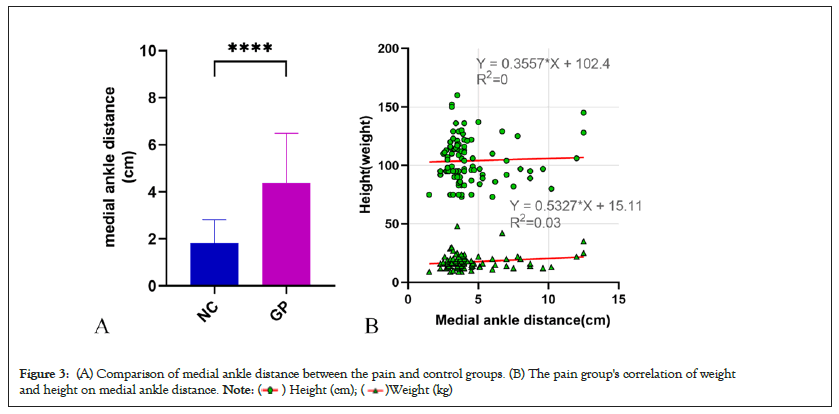
Figure 3: (A) Comparison of medial ankle distance between the pain and control groups. (B) The pain group's correlation of weight
and height on medial ankle distance.  .
.
Causes of growing pains
Growing pains are one of the children's most common causes of recurrent musculoskeletal pain. Although many scholars have done the research and in-depth scientific work on this before, the cause of growing pains has not been confirmed. The most prominent feature is that most of them occur at night. Under the action of the vague nerve, the pain symptoms will be amplified by the pain sensory and proprioception. Growth hormone release increases at night and is subject to a circadian rhythm. The cellular growth capacity is more vital at night than during the day, which explains the nocturnal pain [2]. A positive family history in some cases of growing pain suggests that genetic factors may play a role in the pathogenesis [1]. One study showed that 20% of patients had a positive family history of growing pain [8]. Theories in 1951 suggested that the cause of growing pains could be emotional or psychological reasons (Figures 4A and 4B) and (Figures 5A and 5B) [6]. The researcher investigated children with growing pains and found that parents of affected children believed they had negative or strong emotions [6]. Since girls have traditionally been considered emotionally vulnerable, there is a difference of opinion regarding gender. Because girls have historically been considered vulnerable to emotional influence, there is disagreement on gender. Our findings on gender contradict this view, with boys being more prevalent than girls, presumably related to high activity levels (Figures 6A and 6B) and (Figures 7A and 7B).
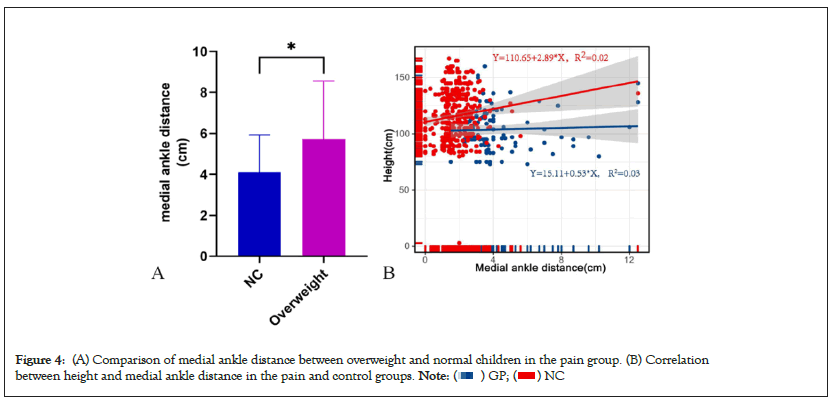
Figure 4: Comparison of medial ankle distance between overweight and normal children in the pain group. (B) Correlation
between height and medial ankle distance in the pain and control groups.  .
.
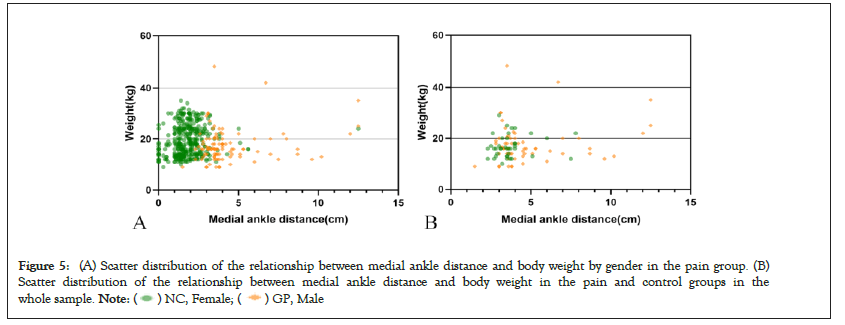
Figure 5: (A) Scatter distribution of the relationship between medial ankle distance and body weight by gender in the pain group. (B)
Scatter distribution of the relationship between medial ankle distance and body weight in the pain and control groups in the
whole sample.  .
.
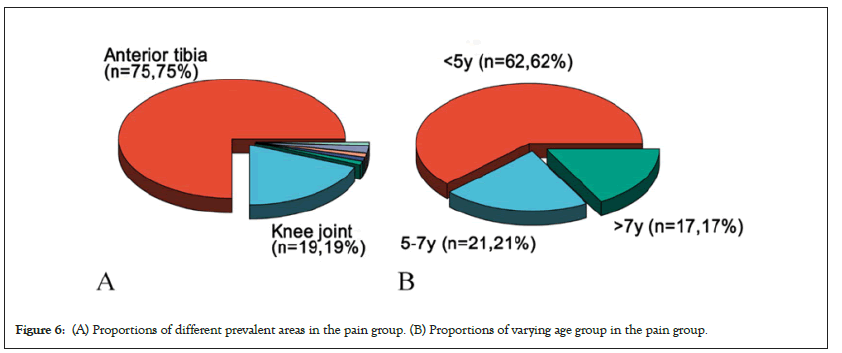
Figure 6: (A) Proportions of different prevalent areas in the pain group. (B) Proportions of varying age group in the pain group.
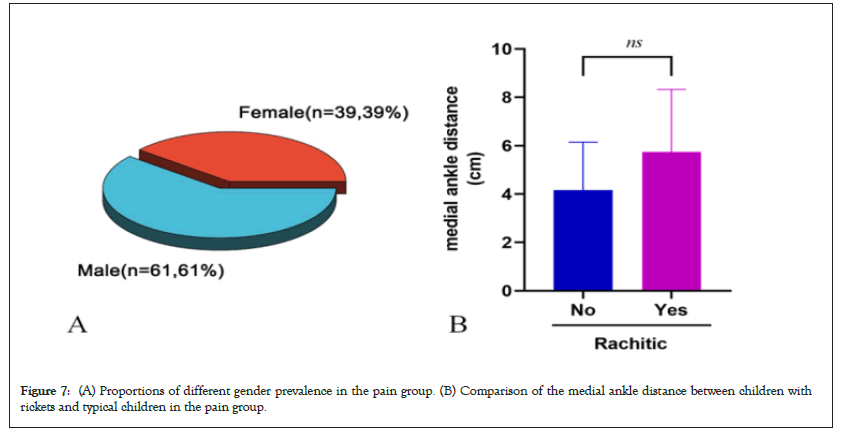
Figure 7: (A) Proportions of different gender prevalence in the pain group. (B) Comparison of the medial ankle distance between children with rickets and typical children in the pain group.
Furthermore, this pathogenesis has been demonstrated in animal experiments: strenuous physical activity may lead to structural abnormalities such as skeletal pain, abnormal medial malleolus distance, and changes in the angle between the mechanical and anatomical axes of the femoral shaft [9]. Also, structural theory suggests that the pain or soreness is due to inflammation caused by muscle fiber damage and that the inflammatory response peaks at 24 hours or 48 hours [10], i.e., pain caused after high levels of physical activity. Although the results suggest that boys are more likely to have the disease than girls, they do not prove that there is no correlation with emotions, as its etiology is due to multiple causes and is the result of a combination of factors. It can be attempted to propose that the etiology of growing pains may be influenced by emotions but may exist only as a causative factor. Since the pathogenesis of growing pains is still unclear, it has been suggested that psychological factors play a role, but no convincing evidence has been found [11]. Anatomical theory suggests that muscular or skeletal changes, such as generalized insufficiency, foot valgus, genu valgum, or scoliosis, may lead to altered gait mechanics and subsequent pain [4].
The relationship between growing pain and medial ankle distance
Based on anatomical theory, it can be speculated that the limbs undergo a growth spurt earlier than the spine and stop growing earlier (14 years for girls and 16 years for boys) [9]. The constant changes in body proportions, weight, muscle strength, and muscle length, in turn, lead to changes in the muscle tension line, thereby increasing the medial malleolus distance. Some research results do not support the anatomical theory of growing pains in young children. That is, anatomical aspects do not necessarily cause pain, but it can also be speculated that the formation of the phenomenon of increased medial malleolus distance cannot be separated from anatomical reasons. This difference in medial ankle distance may be related to the anatomical factors of children's growth and development. When a child begins to walk, the tibia is more curved. To offset the malalignment of the lower limb caused by the inner curvature of the tibia, the human body will compensate for a certain degree of knee curvature. Joint valgus and some children with tibial varus and knee valgus are not corrected in time, resulting in X-shaped legs similar to rickets in a specific age range. That is, the medial ankle distance is higher than average for children. Further research is needed to understand the causes of growing pains to better manage this prevalent disorder in young children.
Relationship between growing pains and body weight
In the course of the study, some cases were found in which weight bearing due to postural deformities (e.g., flat feet, knee joint, or scoliosis) led to increased pressure [12], leading to skeletal pain. It has been shown that children with growing pains have a slight decrease in bone mineral density under ultrasound-based examination, which may promote the development of growing pains associated with increased physical stress in the sense of overload syndrome [2]. Furthermore, we found during our study that children beyond the standard weight had higher medial ankle distances than normal-weight children with growing pains. What is not difficult to see is that growth factors such as musculoskeletal factors have a more significant effect on the medial ankle distance, especially in the presence of increased body load. Vigorous exercise is the most prevalent risk factor for developing functional pain in children as they grow. Increased axial stress on the body from being overweight and certain physical activities involving repetitive high axial loads carry a higher risk of increasing the medial malleolus distance. The increased longitudinal body pressure caused by being overweight may lead to muscle damage, followed by a change in the line of force acting on the tibiofibular and the medial ankle to maintain joint stability after being strained during activity, resulting in an increased medial ankle distance. Some studies have even found that vitamin D deficiency is more common in obese children [13], harming normal bone and force line growth.
Relationship between growing pains and rickets
We can speculate that there may be a relationship between growing pains and rickets due to the insufficient sample size of our data. So there is no data to prove the correlation between growing pains or even to establish a positive relationship between the two in our study, which needs to be confirmed by a large amount of data. In contrast, the theory about bone metabolism is that reduced vitamin D levels lead to growing pains [13]. It has been shown that vitamin D receptors are present in skeletal muscle cells and that both muscle and nervous system components are target organs for vitamin D [13]. Therefore, vitamin D and calcium levels were examined in affected children. Low levels of vitamin D were found in the blood of children suffering from growing pains. Its concentration in the blood was increased after treatment with vitamin D replacement, and the pain was reduced [2], so it can be understood as an intricate link in terms of etiology. It can therefore be proposed that in the presence of the underlying lesion of rickets, the medial ankle distance may become significantly more significant with increased loading of the tibiofibular.
The increased medial ankle distance in children with growing pains compared with normal children suggests an association with genu valgum; no differences in weight and height were found between the two groups. However, there was a significant increase in medial ankle distance in overweight children compared with normal weight children in the growing pains group, as well as some clinical characteristics of children in the pain group in terms of age of onset, age group distribution, pain location, and medical record. This analysis has clinical implications for further understanding and has some clinical significance for further understanding and managing growing pain. However, the relationship between the medial ankle distance and rickets in children needs to be supported by a large amount of data. With growth, most children can regain a standard line of force in the lower extremities, and most of them can be cured if they are detected early with nutritional support and prompt attention. More importantly, regular motor health checks and proactive prevention should be performed on children as they grow. Awareness of a common but highly neglected condition is the cornerstone of successful treatment of growing pains.
Yimeng Sun: study conception and design, data acquisition and analysis and data interpretation. Xifeng Shang: study conception and design. Yongdong Liu: analysis and data interpretation. Jing Zhang: drafting of the manuscript. Qiang Hu: Critical revision. Yutong Liu: Critical revision. The authors read and approved the final manuscript.
All of the following procedures were in accordance with the ethical standards of the national committees on human experimentation and the Helsinki Declaration of 1964 and later versions and approved by the Weifang People’s Hospital. The guardians were informed of the objective and content of the study, and provided voluntary informed consent.
[Crossref] [Google Scholar] [PubMed]
[Crossref] [Google Scholar] [PubMed]
[Crossref] [Google Scholar] [PubMed]
[Crossref] [Google Scholar] [PubMed]
[Cross ref] [Google Scholar] [PubMed]
[Crossref] [Google Scholar] [PubMed]
[Crossref] [Google Scholar] [PubMed]
[Crossref] [Google Scholar] [PubMed]
[Crossref] [Google Scholar] [PubMed]
[Crossref] [Google Scholar] [PubMed]
Citation: Sun Y, Liu Y, Zhang J, Hu Q, Liu Y, Shang X (2023) Correlation and Significance of Clinical Multi-Factors in Children with Growing Pain. Clin Pediatr. 8:235.
Received: 01-Feb-2023, Manuscript No. CPOA-22-20984; Editor assigned: 03-Feb-2023, Pre QC No. CPOA-22-18956 (PQ); Reviewed: 17-Feb-2023, QC No. CPOA-22-20984; Revised: 24-Feb-2023, Manuscript No. CPOA-22-18956 (R); Published: 06-Mar-2023 , DOI: 10.35248/2572-0775.23.8.235
Copyright: © 2023 Sun Y, et al. This is an open-access article distributed under the terms of the Creative Commons Attribution License, which permits unrestricted use, distribution, and reproduction in any medium, provided the original author and source are credited.